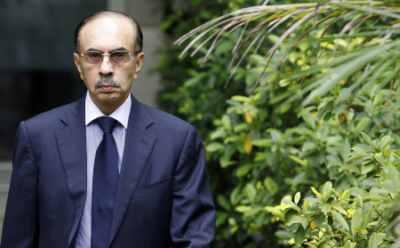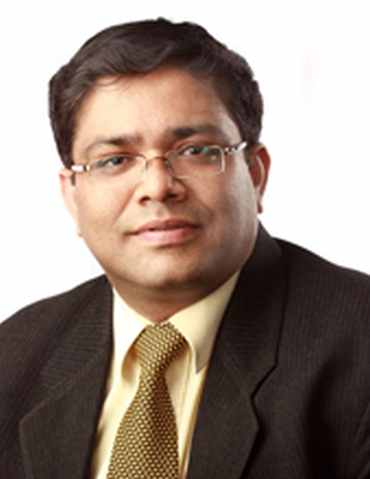 | « Back to article | Print this article |
How Godrej is writing a new story
As our by cameraman gets ready to shoot, the team gathers around a chair with the very ornate twin lion heads. That is where the 70-year-old Adi Godrej will take his place for the group photo.
But when he walks in, he avoids the chair and proceeds to stand with the young team who complete the frame.
The third generation head of the 115-year-old business group, Adi Godrej, does not want to draw a line between him and a team that, he admits, has taught him to listen better.
For Rediff Realtime News On February 28 National Strike Click Here
Click NEXT to read more...
How Godrej is writing a new story
The Godrej Group is scripting its future. We have heard of the infusion of young blood, both family and non-family, we have seen its concentrated acquisition spree, witnessed its rebranding and most recently, injection of private equity by Temasek. Are these part of a bigger game plan or just something it is crossing off the list of to-dos-to-stay-in-the news?
If the more profound adjustments behind the scenes take root, we will see the Godrej Group in a new avatar sooner than later.
It has the goal of growing 10 times (to Rs 1.5 lakh crore) over the next 10 years and get a firmer foothold in the three segments of homecare, personal care and hair colour in the three continents of Asia, Africa and Latin America. The recent changes are as much about staying relevant as they are about learning to listen better and deciding what to support and what to leave out.
Click NEXT to read more...
How Godrej is writing a new story
Listening better
Statistics say that only about 3 per cent of family-owned businesses operate beyond the fourth generation. The Rs 14,500-crore (Rs 145 billion) Godrej Group is one of them, thanks largely to canny diversification, strong financials and smooth change of guard.
The 90s saw the company forge joint ventures with multinationals and modernise its management methods; the turn of the millennium saw Godrej restructure the group with separate CEOs leading the different businesses as separate companies.
Yet, by then some of its well-known brands were flagging, some of its partnerships got waylaid and it was seen to be wary of testing waters for new businesses. Says a senior investment banker, "He (Adi Godrej) now has younger people he trusts to run the show. Earlier, he lacked the conviction to succeed at riskier ventures. The older group of employees thought in a similar fashion. If before 2006, he was micromanaging 80 per cent of the businesses, now it is around 5-7 per cent."
Click NEXT to read more...
How Godrej is writing a new story
Adi Godrej has made changes in his management style too. He claims to listen more to those younger to him by 20-30 years.
"I have learnt to listen better to people's views, both in and outside the organisation. I am much older than the typical Indian consumer today, there are youngsters in the Group who understand them much better than I," he explains.
His daughters Tanya Dubash and Nisaba Godrej call the shots in marketing, branding, personnel and innovation for Godrej Industries, the more dynamic holding company in the group, while son Pirojshah has taken over Godrej Properties, one of Godrej Industries (GI) businesses.
<P>Click <STRONG>NEXT </STRONG>to read more...</P>
How Godrej is writing a new story
The group has gained from listening to outsiders. Vivek Gambhir, for example, who consulted with GI in repositioning the consumer products business (now GCPL) when he was a partner at Bain & Company, a global management consulting firm, came on board as the chief strategy officer for Godrej Industries, to orchestrate the international acquisitions.
Listening better ensured the young managers were given more autonomy. Godrej points out, "As people deliver strongly, you empower them even more."
As a result, Godrej Industries has seen executives in their thirties and forties coming up with nimbler and crisper strategies for the various businesses of the holding company.
Thirty-three year-old Omar Momin, who is the executive vice-president of strategy and business development, says, "The autonomy of my team is indispensable and unparalleled. I have a free hand in deciding which international businesses to acquire. You can get time with Mr Adi Godrej within a working day — that is how accessible he is."
Click NEXT to read more...
How Godrej is writing a new story
Gambhir says that is one of the biggest edges Indian entrepreneurial businesses have: "Decisions can be taken very fast because the onus lies with the entrepreneurs."
A monthly general management meeting has the top management not only discussing each business' forecast for the next month but also listening to guest speakers from one of the Godrej Group businesses who apprise them of the segment.
Sumit Mitra, the executive vice-president of corporate HR at Godrej Industries, had a hand in encouraging and respecting autonomy. Mitra started with a metric, economic value added, which linked performance to not just profits but the average cost of capital (weighted). It improves an employee's chances to earn a bonus up to seven times of the average reward.
Click NEXT to read more...
How Godrej is writing a new story
Mitra explains, "It allowed young people to take on more responsibilities. They also realised that working in silos would not get them anywhere. If it hadn't been for this we would not have seen so much talent come up through the system to take on these roles."
By roles he means senior executive positions for which Godrej Industries wants to hone leaders from within. A programme called 'Bedharak Bolo' topped off by an annual award initiated eggs employees to speak their minds at the meetings, including upcountry young managers who might hesitate in a corporate environment. Momin adds, "People are more willing to try things on their own rather than wait for it to be sanctioned first."
Sunil Kataria, executive vice-president, sales and new business development, GCPL, explains how listening to the frontline sales people will help GCPL: "The rural network we have created will help us drive more usage in rural markets which can't be tapped with urban insights. A festival like Nagpanchami, for example, celebrated only in certain parts near Lucknow, sees a spike in mehndi sales. So we could easily run a local activation 15 days prior to it to maximise sales by keeping our ears to the ground." This also bears testimony to the kind of autonomy the GCPL sales team's regional units enjoy.
Click NEXT to read more...
How Godrej is writing a new story
Listening to different businesses has also helped the group's environmental efforts. Tina Trikha, associate vice-president of strategy and planning, GI, recounts that suggestions on water harvesting, saving power and improving engineering efficiency have flowed freely between the Chemicals, Agrovet, GCPL and Godrej & Boyce units.
Most of all, listening helped in correcting Godrej's corporate image. While earlier its range of indestructible safes and dependable fridges gave it a halo of trust, the association got fuzzy with time as the group started focusing on other categories.
The products which the Group wanted to highlight were either not performing well or were straddling the commoditised mass market.
Click NEXT to read more...
How Godrej is writing a new story
"By 2020, the majority of the Indians would have been those born after 1990. While we may have been the most trusted and reliable brand, customers in another 10 years would never have any affiliation for our brand," says Gambhir.
Ashutosh Tiwari, executive vice-president of strategic marketing for the entire group (and not just Godrej Industries), says, "Consumers told us that we needed to become younger with innovations. If earlier, the Group was an operation-centric entrepreneurial powerhouse, it now needed to be brand-centric."
Out came new brand values -- progression, expression, empathy and experience as part of their motto of 'Brighter Living'. Everything from HR practices to business processes are being aligned to these traits as distilled in 2008.
Tracking brand indicators have told him that the 'intent to purchase' Godrej brands have increased among the 25-35 year olds in metros and mini-metros, an audience the Godrej Group wants to tap in earnest with its mass-premium brands. This consumer segment is different from its earlier core group who were the middle-aged, mid-market and resided in small towns.
Click NEXT to read more...
How Godrej is writing a new story
What to leave out
As much as improving its listening skills have worked, what has helped Godrej Industries and in a way the Group, is the ability to define the core of each of its businesses and processes.
"Good strategy is not just about what to do but also what not to do," surmises Gambhir. So, in consumer goods, food is at the bottom of the list. It was hived off in 2006-07 as a separate business and then a JV with Hershey.
The Godrej Industries would not be looking at food for acquisitions nor would it be investing any further in the joint venture, according to analysts.
"Strategically, we have made the call that while food is interesting, it does not belong to GCPL. We can grow in our three core but low penetrated segments rather than come in at number 5-6 in food. The innovation cycles and distribution are very different. Paanwalas who could be the common-ground account for just 30 per cent in confectionary, for example," adds Gambhir.
Click NEXT to read more...
Title:How Godrej is writing a new story
So too the intent to stay away from soaps in its international FMCG acquisitions, while it is a sizeable earner in India. Entry barriers in soaps are low, making for a low profitability business, says Gambhir.
Deciding what to drop has helped turn around Godrej Agrovet. Mark Kahn, executive vice-president of strategy and business development at Godrej Agrovet, says sales finally took off after the common sales force was taken apart and each member was trained for a certain specialisation.
Agrovet's biggest business of animal feeds has separate teams for feeds of different farm animals. Agrovet also did away with the federal mill structure and centralised quality control and supply chain, leading to immediate margin gains.
Click NEXT to read more...
How Godrej is writing a new story
The Group also pruned Agrovet's retail play. "Retail was haemorrhaging the company. We would joke about how the profit from our animal feeds business was paying for our retail losses. We did not have the deep pockets to sustain the oversold opportunity in rural retail," says Kahn. Aadhar was sold to the Future Group while Nature's Basket was brought under Godrej Industries and billed as a vanguard brand.
The brand architecture also told the group which brands to put its might behind and from which to distance itself.
So while Godrej Nature's Basket would reinforce aspirational values as a gourmet food chain, the master brand would be distanced from Navtal, a brand of Godrej Locks, the flagship company of Godrej & Boyce.
The reason was that selling locks was based on evoking fear among consumers, and no longer in tune with the master brand's new values.
Click NEXT to read more...
How Godrej is writing a new story
Brands such as Interio, Eon and Goodknight fitted its mass-premium stance, while Godrej No 1 and Expert No 1 were seen as vehicles to remain in touch with mass consumers. Most of these brands will double as platforms for future extensions.
"We will create a portfolio play for our star GCPL brands because they are inherently strong and can be extended into more segments," notes Tarun Arora, executive vice-president, marketing, GCPL.
The Expert brand which saw a redesign and extensions also had the design team deciding on the priorities.
Click NEXT to read more...
How Godrej is writing a new story
"We decreased the amount of text declaring benefits on the packs. It was more to-the-point. We did not claim 100 per cent herbal for our variant of herbal-based Expert powder unlike henna powder packs in the market. So the design was more authentic and easier to connect with," points out GI's associate vice-president of design, Darshan Gandhi.
"Nature's Basket will exist to remind us how we can stretch brand Godrej to premium segments. Ten years ago, people would have scoffed at it saying we were mass. But now they want us to write Godrej's Nature's Basket," says Gambhir. He points out that Godrej Industries would be open to partnerships to shorten the learning curve and drive scale.
The other element that drives Godrej Group's new strategy is what not to accept in a partnership. From P&G for soaps, GE for refrigerators, Sara Lee for personal care to the more recent Hershey's for food and Tyson for poultry joint ventures, Godrej has taken on partners since the nineties but has had a somewhat patchy record.
Click NEXT to read more...
How Godrej is writing a new story
"One of our biggest learnings in the last five years has been that partnerships need to have a defined period in which each side will gain. We will not be just a distributing partner but add skills to our company through JVs," says Gambhir.
Both Kahn and Gambhir echo each other in citing Tyson as the ideal partner which turned around its struggling poultry business through its supply chain and technology knowhow and was willing to innovate based on insights on vegetarian food preferences Godrej gave it.
Even their latest international acquisition of 60 per cent in the Chilean Cosmetica Nacional will eventually see Godrej buy out the rest of the equity. Closer home, it led to consolidation of the Sara Lee range of products into GCPL.
Click NEXT to read more...
How Godrej is writing a new story
While the changes backstage will take time to reflect in terms of bottom line results, both Mitra and Tiwari tell that the efforts are bearing fruit.
Mitra says Godrej Industries is now getting job applications from candidates and institutions that wouldn't have Godrej in their consideration set earlier and that during the summer placements last year it had a 98 per cent acceptance of its offer letters.
For the team at the helm of the Godrej Group this is among the key indicators of how things will pan out in the days to come.














